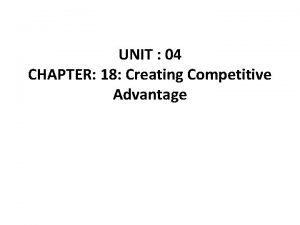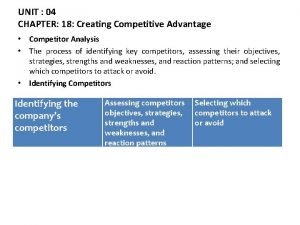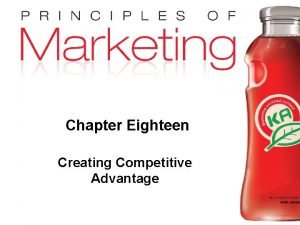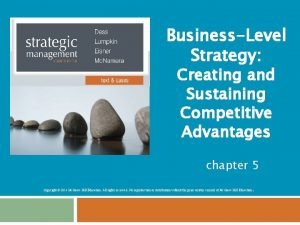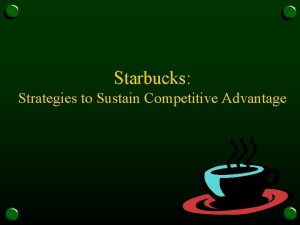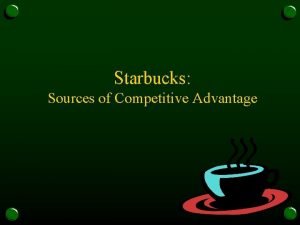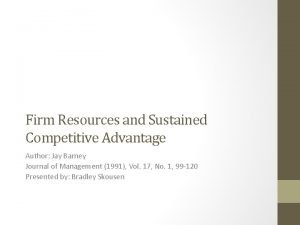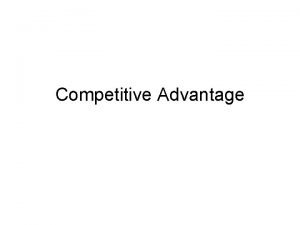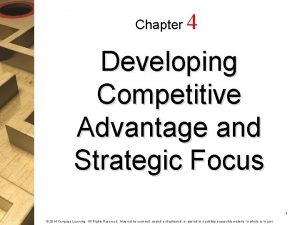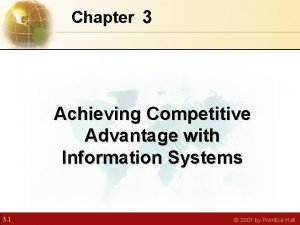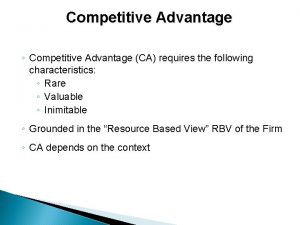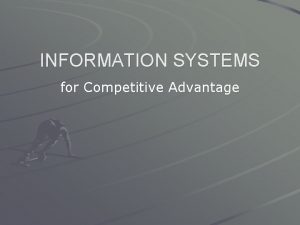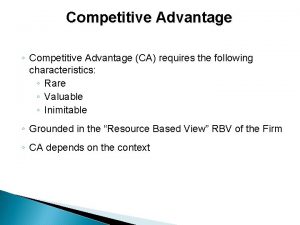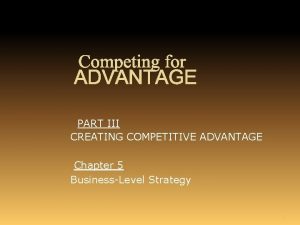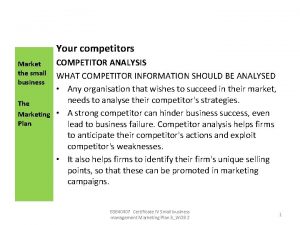UNIT 04 CHAPTER 18 Creating Competitive Advantage Competitor






















- Slides: 22

UNIT : 04 CHAPTER: 18: Creating Competitive Advantage • Competitor Analysis • The process of identifying key competitors, assessing their objectives, strategies, strengths and weaknesses, and reaction patterns; and selecting which competitors to attack or avoid. • Identifying Competitors Identifying the company’s competitors Assessing competitors objectives, strategies, strengths and weaknesses, and reaction patterns Selecting which competitors to attack or avoid

Assessing Competitors • Determining Competitors’ Objectives • Identifying Competitors’ Strategies • Assessing Competitors’ Strengths and Weaknesses • Estimating Competitors’ Reactions Selecting Competitors to Attack and Avoid • Strong or Weak Competitors • Close or Distant Competitors • Good or Bad Competitors • Finding Uncontested Market Spaces Designing a Competitive Intelligence System Competitive Strategies Approaches to Marketing Strategy • Entrepreneurial marketing • Formulated marketing • Intrepreneurial marketing

Basic Competitive Strategies • Overall cost leadership • Differentiation: • Focus Michael Treacy and Fred Wiersema suggested: • Operational excellence • Customer intimacy • Product leadership Competitive Positions Market leader Market challengers Market followers Market nichers 40% 30% 20% 10%

Strategies for Market Leaders, Challengers, Followers, and Nichers Market Leader Strategies Market Challenger Strategies Market Follower Strategies Market Nicher Strategies Expand total market Full frontal attack Follow closely By customer, market, qualityprice, service Protect market share Indirect attack Multiple niching Expand market share Follow at a distance

Market Leader Strategies • Expanding Total Demand • Protecting Market Share • Expanding Market Share Market Challenger Strategies • The challenger can attack the market leader, a high-risk but potentially high-gain strategy. Its goal might be to take over market leadership. • Or the challenger’s objective may simply be to wrest more market share. • Market Follower Strategies Prefer to follow rather than challenge the market leader. • Market Nicher Strategies

Balancing Customer and Competitor Orientations • Competitor-centered company • Customer-centered company • Market-centered company

Chapter: 19: The Global Marketplace Global Marketing Today Global firm • A firm that, by operating in more than one country, gains R&D, production, marketing, and financial advantages in its costs and reputation that are not available to purely domestic competitors.

Looking at the Global Marketing Environment • The International Trade System • The World Trade Organization and GATT • Regional Free Trade Zones • Economic Environment – Subsistence economies: In a subsistence economy, the vast majority of people engage in simple agriculture. – Raw material exporting economies: These economies are rich in one or more natural resources but poor in other ways. – Emerging economies (industrializing economies): In an emerging economy, fast growth in manufacturing results in rapid overall economic growth. – Industrial economies: Industrial economies are major exporters of manufactured goods, services, and investment funds.

Political-Legal Environment Cultural Environment • The Impact of Culture on Marketing Strategy • The Impact of Marketing Strategy on Cultures Deciding Whether to Go Global Deciding Which Markets to Enter Demographic Characteristics Sociocultural Factors • Education • Consumer lifestyles, beliefs, and values • Population size and growth • Business norms and approaches • Population age composition • Cultural and social norms Geographic Characteristics • Languages • Climate Political and Legal Factors • Country size • National priorities • Population density-urban, rural • Political stability • Transportation structure and market • Government attitudes towards global accessibility trade Economic factors • Government bureaucracy • GDP size and growth • Monetary and trade regulations • Income distribution • Industrial infrastructure • Natural resources • Financial and human resources

• Market Entry Strategies

Deciding How to Enter the Market • Exporting • Joint venturing: • Entering foreign markets by joining with foreign companies to produce or market a product or service. – Licensing – Contract Manufacturing A Joint venture in which a company contract with manufacturers in a foreign market to produce the product or provide its service. • Management contracting: A joint venture in which the domestic firm supplies the management knowhow to a foreign company that supplies the capital; the domestic firm exports management services rather than products. • Joint ownership: • A joint venture in which a company joins investors in a foreign market to create a local business in which the company shares joint ownership and control. Direct investment • Entering a foreign market by developing foreign-based assembly or manufacturing facilities.

Deciding on the Global Marketing Program • Standardized global marketing An international marketing strategy that basically uses the same marketing strategy and mix in all of the company’s international markets. • Adapted global marketing An international marketing strategy that adjusts the marketing strategy and mix elements to each international target market, bearing more costs but hoping for a larger market share and return. Product • Straight product extension: Marketing a product in a foreign market without any change. • Product adaptation: Adapting a product to meet local conditions or wants in foreign markets • Product invention: Creating new products or services foreign markets.

• Five Global Product and Communications Strategies

Promotion Communication adaptation: • A global communication strategy of fully adapting advertising messages to local markets. Price Distribution Channels • An international company must take a whole-channel view of the problem of distributing products to final consumers. Whole-Channel Concept for International Marketing Deciding on the Global Marketing Organization

Chapter: 20: Social Responsibility and Ethics • Responsible marketers • Sustainable marketing: Socially and environmentally responsible marketing that meets the present needs of consumers and businesses while also preserving or enhancing the ability of future generations to meet their needs.

Social Criticisms of Marketing’s Impact on Individual Consumers High Prices • High Costs of Distribution: • High Advertising and Promotion Costs • Excessive Markups Deceptive Practices High-Pressure Selling Shoddy, Harmful, or Unsafe Products Planned Obsolescence Poor Service to Disadvantaged Consumers • Underserved consumers: Because of the lack of supermarkets in lowincome areas, many disadvantaged consumers find themselves in “food deserts, ” with little or no access to healthy, affordable fresh foods.

Marketing’s Impact on Society as a Whole • False Wants and Too Much Materialism • Too Few Social Goods • Cultural Pollution Marketing’s Impact on Other Businesses • False Wants and Too Much Materialism • Too Few Social Goods • Cultural Pollution

Marketing’s Impact on Other Businesses Consumer Actions to Promote Sustainable Marketing Consumerism • The right to introduce any product in any size and style, provided it is not hazardous to personal health or safety, or, if it is, to include proper warnings and controls • The right to charge any price for the product, provided no discrimination exists among similar kinds of buyers • The right to spend any amount to promote the product, provided it is not defined as unfair competition • The right to use any product message, provided it is not misleading or dishonest in content or execution • The right to use buying incentive programs, provided they are not unfair or misleading

Traditional buyers’ rights include the following: • The right not to buy a product that is offered for sale • The right to expect the product to be safe • The right to expect the product to perform as claimed Consumer advocates call for the following additional consumer rights: • The right to be well informed about important aspects of the product • The right to be protected against questionable products and marketing practices • The right to influence products and marketing practices in ways that will improve “quality of life” • The right to consume now in a way that will preserve the world for future generations of consumers

• Environmentalism: An organized movement of concerned citizens and government agencies to protect and improve people’s current and future living environment. • Environmental sustainability: A management approach that involves developing strategies that both sustain the environment and produce profits for the company The Environmental Sustainability Portfolio

Public Actions to Regulate Marketing Business Actions toward Sustainable Marketing Principles • Consumer-oriented marketing: A principle of sustainable marketing that holds a company should view and organize its marketing activities from the consumer’s point of view. • • • • Customer-value marketing: A principle of sustainable marketing that holds a company should put most of its resources into customer-value-building marketing investments. Innovative marketing: A principle of sustainable marketing that requires a company seek real product and marketing improvements. Sense-of-mission marketing: A principle of sustainable marketing that holds a company should define its mission in broad social terms rather than narrow product terms. Societal marketing: A principle of sustainable marketing that holds a company should make marketing decisions by considering consumers’ wants the company’s requirements, consumers’ long-run interests, and society’s long-run interests.

• FIGURE | 20. 4: Societal Classification of Products • Deficient products: Products that have neither immediate appeal nor long-run benefits. Pleasing products: Products that give high immediate satisfaction but may hurt consumers in the long run. Salutary products: Products that have low appeal but may benefit consumers in the long run. Desirable products: Products that give both high immediate satisfaction and high long-run benefits. • • • Marketing Ethics The Sustainable Company
 Chapter 18 creating competitive advantage
Chapter 18 creating competitive advantage Chapter 18 creating competitive advantage
Chapter 18 creating competitive advantage Chapter 18 creating competitive advantage
Chapter 18 creating competitive advantage Chapter 18 creating competitive advantage
Chapter 18 creating competitive advantage Porters 3 generic strategy
Porters 3 generic strategy Rivalry chapter 5
Rivalry chapter 5 Chapter 2 strategic planning for competitive advantage
Chapter 2 strategic planning for competitive advantage Which market is the least competitive
Which market is the least competitive Therapeutic index
Therapeutic index Industry and competitor analysis
Industry and competitor analysis Jay b barney
Jay b barney Starbucks competitive strategy
Starbucks competitive strategy What is starbucks competitive advantage
What is starbucks competitive advantage Human resources management gaining a competitive advantage
Human resources management gaining a competitive advantage Downsizing
Downsizing Human resource management gaining a competitive advantage
Human resource management gaining a competitive advantage Levi's competitive advantage
Levi's competitive advantage Barney 1991 firm resources
Barney 1991 firm resources Quotes on competitive advantage
Quotes on competitive advantage Bases of competitive advantage
Bases of competitive advantage Generic building blocks of competitive advantage
Generic building blocks of competitive advantage Developing a firm's strategy canvas focuses on
Developing a firm's strategy canvas focuses on Achieving competitive advantage with information systems
Achieving competitive advantage with information systems
